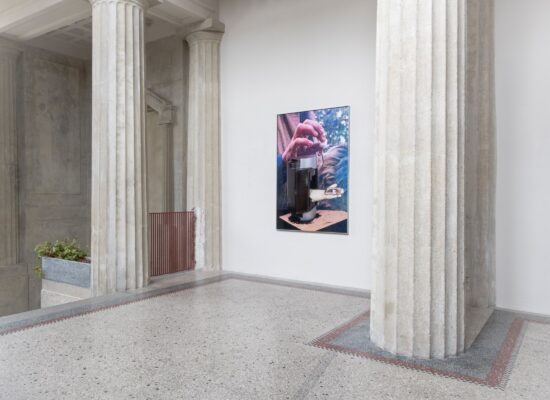Artists Aline Witschi
Date 22.11. – 11.1.2025
Venue Krone Couronne
Text Camille Regli
Photography Michal Schorro
First sketched in a large sketchbook, Aline’s sculptures crystallise in her medium of choice: clay. Rooted in rigorous, tactile and repetitive engagement with the material, and using exclusively natural pigments, the works evoke a sense of timelessness, hovering between futuristic messages and remnants of the past.
Your sculptures take us into a universe imbued with fantasy while evoking simultaneously a distinctly organic aesthetic. What are the inspirations or recurring themes in your work?
The themes and inspirations of my work are closely tied to the material—in this case, clay. After all, clay is the very substance on which we live and from which all life emerges. For me, clay also carries a temporal dimension: archaeological excavations uncover clay relics that connect the past to the present, like a thread drawn up from the depths of time. Through my works, I try to weave into this thread, making mental leaps across time, moving forward and backward, up and down. With my hands, I shape clay surfaces that, even when freshly fired, feel as if they had already been reclaimed by time.

Your fascination with clay is indeed unwavering. It’s not just a material you employ, but one you thematise. Could you share a few words about what initially drew you to this material, and what continues to inspire you to work with it? When did it first become part of your practice?
My first in-depth engagement with clay was during my bachelor’s studies, where I explored textile surfaces through drawing and later translated these into small clay “hooks”. This led to installations using straight metal rods and eventually metal circles. I am fascinated by the initially soft, malleable state of clay, which then becomes hard and brittle. By working with clay’s forms and movable joints, I am trying to unify the contrasting qualities of these states. I often think of frameworks, like the skeletal structure of the human body, and expand on the idea that life is built upon rigid systems—systems that sometimes need to be disrupted.

You also mention the importance of repetition in your practice—an obsession with the material, the gesture, the routine—a kind of mono-materiality that shapes your work. What does that repetitive gesture mean to you?
Working with my body and especially my hands is important to my practice. My focus lies in shaping the material, and the repetitive steps of the process create space for reflection. Repetition becomes a soothing yet cohesive element of my work. Perhaps it is a way of coming to terms with repetition in life—with life itself, its progressions, its fractures, and the tension between all of these.

While some of your pieces evoke forms of armour or chainmail, the material itself conveys a sense of fragility and poetry, creating a compelling tension in how we bodily and emotionally engage with the works. Could you elaborate on this tension?
Let’s begin with a mental image: armour and chainmail envelop the human body. On one side, they reveal the interior and the organism, while on the other side, they show the external, worldly landscape. The body’s sensory organs, along with the skin, tiny hairs, and similar elements, form the transition between these two worlds. It’s an interplay between these sides, and I inevitably think of emotional and physical, undefinable forms that flow back and forth across these layers. This idea gives rise to works that can no longer be clearly assigned to either side. Perhaps this is the tension you refer to.

Looking at the titles of your works, they often allude to marine, terrestrial, and astral realms. You describe your works as “grounded” in the earth, with a terrestrial quality, but they also seem extra-terrestrial, suggesting an emancipatory potential—a sense of wonder or escape toward a more symbiotic world. How do you connect with this?
If the Earth is viewed as the sum of all organisms and thus seen as a body in itself – as described in James Love-lock’s Gaia Hypothesis– it might be easier to understand the idea that everything inexplicable and distant can serve as an attempt to create a concept for the incomprehensible using clay (earth). Stars and sparks seem to linger in my work, perhaps because clay is a non-conductive material, whereas we, humans, are so closely connected to the digital. It would be wonderful if my works could inspire viewers to see themselves as part of a larger, reciprocal system—a symbiotic and ever-chan-ging exchange—and perhaps to break free for an instant from an individual perspective.

Where does the title of the exhibition come from?
The title “Hit and Heart Points” refers to the digital world of gaming, in which “hit points” decide over life and death, and “heart” to the organic dimension, which stands for emotions and life. The flowers that often spread in my works are modelled from small hearts. The contrast to the digital world and the connection to the chessboard pattern in the large eponymous wall relief—in which sensory organs struggle with the rigid structures of the chessboard—perhaps best illustrate the title.




